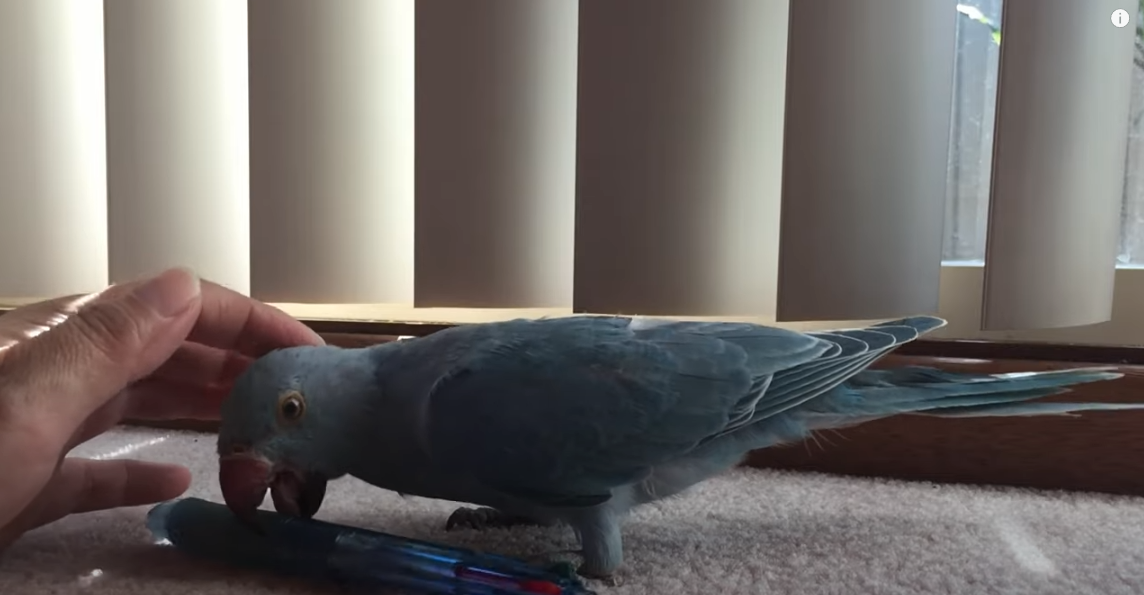Bluffing is a common stage for young Indian Ringnecks. During this phase, the bird may act more aggressively, lunging or biting without the intention to harm. It can feel like your bird is turning on you, but this behavior is normal. A gentle, evidence-based approach is the best way to deal with bluffing.
I’ve been following this Indian Ringneck named Claw for about four years on YouTube. Claw’s owner has integrated him fully into their family, and their approach to training and handling is inspiring. When Claw went through his bluffing stage, the owner avoided harsh methods. They used positive distractions and ignored lunging behavior instead of reacting forcefully. Some people use harmful tactics like spraying water, flicking the beak or wobbling the bird when perched, but these methods are not only abusive—they simply don’t work. Birds have a long memory and are naturally cautious creatures. Harsh treatment creates lasting fear and aggression that can take years to undo, if it can be undone at all.
So, what’s the best way to handle bluffing? The answer is distraction or ignoring the unwanted behavior. For instance, when Claw started bluffing, his owner used a pen as a distraction. It was Claw’s favorite item, so he used the pen for Claw to chew on while petting his bird. This tactic worked wonders. Over time, Claw became more comfortable with handling and eventually petting. This consistent interaction, if done by any owner, can lead to more advanced handling, such as letting the owner touch their bird’s feet, wings, and even their bird’s tail. Progressing to such handling is ideal, as the bird will eventually need grooming. As a result, this will remove unneeded stress.
If our readers have time to investigate Claw’s YouTube Channel, they will see how tame and wonderful Claw is. He’s such an amazingly beautiful ringneck that’s about four years old. The owner has obviously worked hard to build a trusting relationship with patience, love, and consistency. These relationships are ideal as almost anything can be built upon such foundations – such as handling the bird on its back, trick training, grooming, or exposing the bird to unfamiliar objects and environments. Bravo to Claw’s owner for showing the world how amazing a pet ringneck can be!
When reviewing this video, I loved watching how Claw’s owner was gentle and patient, always giving him the option to back away. This made Claw more confident and allowed him to make the decision and adjust to being petted; he learned that he wouldn’t be forced into anything he didn’t want to do. It is important to note all birds are highly neophobic and need several positive experiences to become confident.
When my own ringnecks went through the bluffing stage, I used similar methods. I would distract them with toys or gently blow on their faces to avoid bites. When training Archimedes, who was prone to biting fingers, I used a spoon to deliver treats so I could reward him without risking a bite. Every interaction was designed to result in a positive outcome. I never forced him to do what he didn’t; instead, I guided him to make better choices. Over time, Archimedes learned that good behavior brought rewards, and the biting stopped.
The main lesson here is that bluffing doesn’t need to be punished. Instead, use distractions and positive interactions to guide your bird through this stage. Always keep training sessions positive and reward behaviors you want to see more of. This builds trust and helps your ringneck develop a healthy, friendly relationship with you.
If you’d like to learn more about Claw, check out his YouTube channel, where hundreds of videos showcase his progress! Click here to visit “Claw’s Life“


